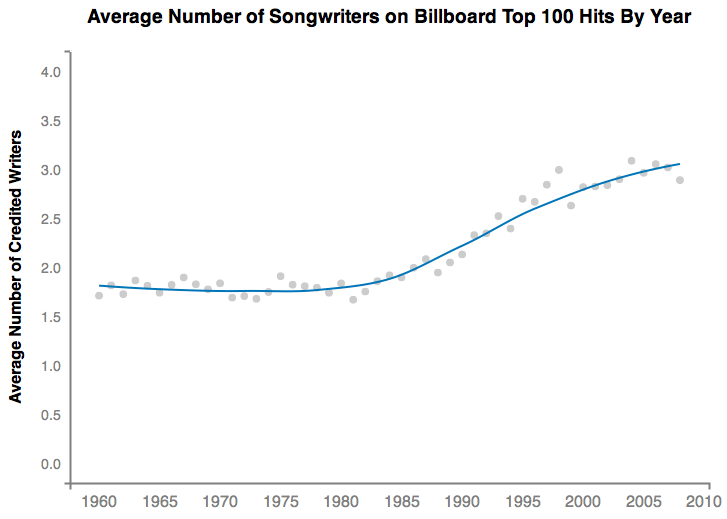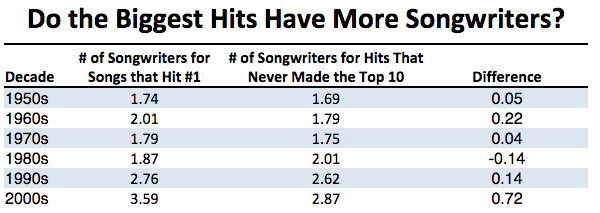The pop star Rihanna relies on a team of songwriters to make her hits.
Unless you’re a pop music junkie, or a New Yorker reader, his name may not be familiar to you, but, by some measures, the 44-year-old Swedish songwriter Max Martin is closing in on the Beatles’ Paul Mccartney as the most successful songwriter in pop history. With The Weeknd’s “Can’t Feel My Face” recently topping the Billboard Charts, Martin has received a songwriting credit on 21 number one-hits. That is third only to Paul Mccartney (32) and John Lennon (26).
But Martin’s run is in a quite different context. Yes, Martin was a writer on “Can’t Feel My Face”, Katy Perry’s “Roar” and Taylor Swift’s “Shake It Off”, but he was far from an auteur. He was one of five credited writers on “Can’t Feel My Face” and “Roar” and one of three on “Shake It Off” (yes, Taylor was one of them).
On a significant number of his 58 top ten hits, Martin is part of a team of more than four writers. In contrast, Lennon and McCartney’s hits were generally written with the other or alone. One song Martin can claim for himself though is Britney Spear’s late 90s pop anthem “… Baby One More Time”. The loneliness must have been killing him.
Chart data shows that Martin is part of a trend of writing pop songs by committee.
We used Billboard Hot 100 data from a publicly available dataset to look at the number of credited writers on songs that reached the Billboard Hot 100 from 1960 to 2008 and discovered a steady increase since the early 1980s. The chart below displays this trend. We removed the 19% of songs that were missing songwriting information from the dataset, and do not believe it impacts the conclusions.

Dan Kopf, Priceonomics; Data: Billboard
In the early 1980s, the average number of songwriters on a pop hit was fewer than two, but by the late 2000s, this had increased to over 3. To check if this trend continues, we hand coded a random set of 150 Hot 100 songs from 2015. The movement does not appearing to be slowing down. We found that the average number of songwriters is getting closer to four.
Prior to the 1990s, the percentage of Billboard Hot 100 songs with 4 or more writers was never greater than 10% in a given year. By 2001, this number was consistently over 25%. The following chart shows the growth of this number. We excluded the years 1980-1982, for this measure, because too much of the songwriters’ data was missing.

Dan Kopf, Priceonomics; Data: Billboard
Increasingly, it takes a village to write a pop hit.
This trend is even more pronounced at the top of the charts. By decade, we looked at the number of writers on #1 songs versus songs that made the Billboard Hot 100 chart, but not the top 10. In the 1990s and previous decades, the number of songwriters for top songs and the ones below them was similar, but the number of songwriters on the megahits took a big jump in the 2000s.

So what’s going on here? Why does it take so many songwriters to write a chart topper these days? We consider three possible cause of songwriter inflation.
Specialization
Pop music is big business and big business leads to the division of labor.
In “The Song Machine”, a New Yorker article on modern pop, John Seabrook explains how specialization in songwriting works. He gives the example of Rihanna’s 2010 number one hit “What’s My Name.” The song began as a backing track created by the Norwegian production duo of Mikkel Eriksen and Tor Erik Hermansen (known as Stargate). At this early stage, all there is to the track is a beat, chord progression and synth arrangement. The producers then called in the songwriters Ester Dean, to work on the melody, and Traci Hale, to assist them with the lyrics. Finally, the rapper Aubrey Graham (aka Drake) was asked to do a verse on the song, which he wrote himself, as far as we know.
And there you have it, five songwriters: Eriksen, Hermansen, Dean, Hale and Graham (notice that Rihanna is not of them). This style of writing a song is increasingly common. Given the huge amounts of money at stake (Rihanna’s 2013 tour generated $140 million dollars in revenue), it is reasonable for record labels to spend money on the best people at every aspect of the songwriting process.
The Rise of Hip Hop
Until the 1990s, Hip hop did not have a large presence on the Hot 100. Songs in this genre have more songwriters because they credit all the rappers, the music producers, and any bands they sample. It is this dynamic that led to the 11 credited songwriters on Puff Daddy’s “Can’t Nobody Hold Me Down,” which samples Matthew Wilder’s “Break My Stride” and Grandmaster Flash and the Furious Five’s “The Message.”

Demanding More Credit
Participants in the making of hits may be increasingly demanding songwriting credits because of their financial value. Songwriters get a share of of the royalties from sales and streams of a song.
Allegedly some pop stars demand songwriting credit when they have made little or no contribution to the song. The songwriter Adonis Shropshire, who has worked with Alicia Keyes and Chris Brown, told the Associated Press that some stars will only work with songwriters if they are given a songwriting credit. Songwriters that have worked with pop stars Beyonce and Avril Lavigne suggest those singers may take credit even when they have only made minor changes to the song. As the saying goes, “change a word and take a third.”
It is also possible that deserving participants now better understand the importance of getting songwriting credit. Robbie Robertson, the lead songwriter in “The Band”, famously took sole writing credit for the group’s songs, which led to their breakup and a battle over the royalties for their music. This is one of many disputes over the credits to successful songs that eventually became worth a lot of money. It may be that artists today are more aware of the importance of establishing their role in song creation.
***
“I just believe in collaboration,” Max Martin told Pop Justice in 2009. “I mean I’ve written songs on my own, you know, but I think if the artist has something to bring to the table – someone like Pink, for instance – where they have something to say, it makes your job easier and more special.”
Mostly gone are the days of Bob Dylan, Curtis Mayfield or Paul Simon, on their own, agonizing over every detail of a song. Pop music songwriting is increasingly about combining the work of many talented people in the search for a hit. Like it or not, the factory model of making Top 40 seems to work.
For our next post, we explore the ways that the NSA revelations of 2013 affected the way people behave on the Internet. To get notified when we post it → join our email list.
![]()
This post was written by Dan Kopf; follow him on Twitter here.




